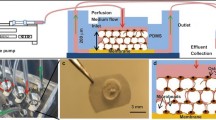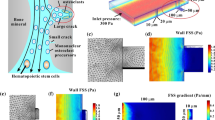Abstract
In our previous work, bone cell networks with controlled spacing and functional intercellular gap junctions had been successfully established by using microcontact printing and self assembled monolayers technologies [Guo, X. E., E. Takai, X. Jiang, Q. Xu, G. M. Whitesides, J. T. Yardley, C. T. Hung, E. M. Chow, T. Hantschel, and K. D. Costa. Mol. Cell. Biomech. 3:95–107, 2006]. The present study investigated the calcium response and the underlying signaling pathways in patterned bone cell networks exposed to a steady fluid flow. The glass slides with cell networks were separated into eight groups for treatment with specific pharmacological agents that inhibit pathways significant in bone cell calcium signaling. The calcium transients of the network were recorded and quantitatively evaluated with a set of network parameters. The results showed that 18α-GA (gap junction blocker), suramin (ATP inhibitor), and thapsigargin (depleting intracellular calcium stores) significantly reduced the occurrence of multiple calcium peaks, which were visually obvious in the untreated group. The number of responsive peaks also decreased slightly yet significantly when either the COX-2/PGE2 or the NOS/nitric oxide pathway was disrupted. Different from all other groups, cells treated with 18α-GA maintained a high concentration of intracellular calcium following the first peak. In the absence of calcium in the culture medium, the intracellular calcium concentration decreased slowly with fluid flow without any calcium transients observed. These findings have identified important factors in the flow mediated calcium signaling of bone cells within a patterned network.






Similar content being viewed by others
References
Batra N. N., Y. J. Li, C. E. Yellowley, L. You, A. M. Malone, C. H. Kim, C. R. Jacobs. Effects of short-term recovery periods on fluid-induced signaling in osteoblastic cells. J Biomech 38:1909–1917, 2005.
Berridge M. J. Inositol trisphosphate and calcium signalling. Nature 361:315–325, 1993.
Berridge M. J., P. Lipp, M. D. Bootman. The versatility and universality of calcium signalling. Nat Rev Mol Cell Biol 1:11–21, 2000.
Chen N. X., K. D. Ryder, F. M. Pavalko, C. H. Turner, D. B. Burr, J. Qiu, R. L. Duncan. Ca2+ regulates fluid shear-induced cytoskeletal reorganization and gene expression in osteoblasts. Am J Physiol Cell Physiol 278:C989–997, 2000.
Clapham D. E. Calcium signaling. Cell 80:259–268, 1995.
Cowin S. C. On mechanosensation in bone under microgravity. Bone 22:119S–125S, 1998.
Donahue S. W., H. J. Donahue, C. R. Jacobs. Osteoblastic cells have refractory periods for fluid-flow-induced intracellular calcium oscillations for short bouts of flow and display multiple low-magnitude oscillations during long-term flow. J Biomech 36:35–43, 2003.
Genetos D. C., D. J. Geist, D. Liu, H. J. Donahue, R. L. Duncan. Fluid shear-induced ATP secretion mediates prostaglandin release in MC3T3-E1 osteoblasts. J Bone Miner Res 20:41–49, 2005.
Genetos D. C., C. J. Kephart, Y. Zhang, C. E. Yellowley, H. J. Donahue. Oscillating fluid flow activation of gap junction hemichannels induces ATP release from MLO-Y4 osteocytes. J Cell Physiol 212:207–214, 2007.
Godin L. M., S. Suzuki, C. R. Jacobs, H. J. Donahue, S. W. Donahue. Mechanically induced intracellular calcium waves in osteoblasts demonstrate calcium fingerprints in bone cell mechanotransduction. Biomech Model Mechanobiol 6:391–398, 2007.
Guo X. E., E. Takai, X. Jiang, Q. Xu, G. M. Whitesides, J. T. Yardley, C. T. Hung, E. M. Chow, T. Hantschel, K. D. Costa. Intracellular calcium waves in bone cell networks under single cell nanoindentation. Mol Cell Biomech 3:95–107, 2006.
Guo Y., C. Martinez-Williams, K. A. Gilbert, D. E. Rannels. Inhibition of gap junction communication in alveolar epithelial cells by 18alpha-glycyrrhetinic acid. Am J Physiol 276:L1018–1026, 1999.
Hung C. T., F. D. Allen, K. D. Mansfield, I. M. Shapiro. Extracellular ATP modulates [Ca2+]i in retinoic acid-treated embryonic chondrocytes. Am J Physiol 272:C1611–1617, 1997.
Hung C. T., F. D. Allen, S. R. Pollack, C. T. Brighton. Intracellular Ca2+ stores and extracellular Ca2+ are required in the real-time Ca2+ response of bone cells experiencing fluid flow. J Biomech 29:1411–1417, 1996.
Iqbal J., M. Zaidi. Molecular regulation of mechanotransduction. Biochem Biophys Res Commun 328:751–755, 2005.
Jorgensen N. R., S. T. Geist, R. Civitelli, T. H. Steinberg. ATP- and gap junction-dependent intercellular calcium signaling in osteoblastic cells. J Cell Biol 139:497–506, 1997.
Jorgensen N. R., Z. Henriksen, C. Brot, E. F. Eriksen, O. H. Sorensen, R. Civitelli, T. H. Steinberg. Human osteoblastic cells propagate intercellular calcium signals by two different mechanisms. J Bone Miner Res 15:1024–1032, 2000.
Jorgensen N. R., S. C. Teilmann, Z. Henriksen, R. Civitelli, O. H. Sorensen, T. H. Steinberg. Activation of L-type calcium channels is required for gap junction-mediated intercellular calcium signaling in osteoblastic cells. J Biol Chem 278:4082–4086, 2003.
Krieger N. S., K. K. Frick, K. LaPlante Strutz, A. Michalenka, D. A. Bushinsky. Regulation of COX-2 mediates acid-induced bone calcium efflux in vitro. J Bone Miner Res 22:907–917, 2007.
Li N., J. Y. Sul, P. G. Haydon. A calcium-induced calcium influx factor, nitric oxide, modulates the refilling of calcium stores in astrocytes. J Neurosci 23:10302–10310, 2003.
Liedert A., D. Kaspar, R. Blakytny, L. Claes, A. Ignatius. Signal transduction pathways involved in mechanotransduction in bone cells. Biochem Biophys Res Commun 349:1–5, 2006.
Looms D. K., K. Tritsaris, B. Nauntofte, S. Dissing. Nitric oxide and cGMP activate Ca2+-release processes in rat parotid acinar cells. Biochem J 355:87–95, 2001.
McGarry J. G., J. Klein-Nulend, P. J. Prendergast. The effect of cytoskeletal disruption on pulsatile fluid flow-induced nitric oxide and prostaglandin E2 release in osteocytes and osteoblasts. Biochem Biophys Res Commun 330:341–348, 2005.
Mogami H., A. V. Tepikin, O. H. Petersen. Termination of cytosolic Ca2+ signals: Ca2+ reuptake into intracellular stores is regulated by the free Ca2+ concentration in the store lumen. Embo J 17:435–442, 1998.
Norvell S. M., S. M. Ponik, D. K. Bowen, R. Gerard, F. M. Pavalko. Fluid shear stress induction of COX-2 protein and prostaglandin release in cultured MC3T3-E1 osteoblasts does not require intact microfilaments or microtubules. J Appl Physiol 96:957–966, 2004.
Pozzan T., R. Rizzuto, P. Volpe J. Meldolesi. Molecular and cellular physiology of intracellular calcium stores. Physiol Rev 74:595–636, 1994.
Ralston S. H., D. Todd, M. Helfrich, N. Benjamin, P. S. Grabowski. Human osteoblast-like cells produce nitric oxide and express inducible nitric oxide synthase. Endocrinology 135:330–336, 1994.
Rubin J., C. Rubin, C. R. Jacobs. Molecular pathways mediating mechanical signaling in bone. Gene 367:1–16, 2006.
Sato K., A. Suematsu, T. Nakashima, S. Takemoto-Kimura, K. Aoki, Y. Morishita, H. Asahara, K. Ohya, A. Yamaguchi, T. Takai, T. Kodama, T. A. Chatila, H. Bito, H. Takayanagi. Regulation of osteoclast differentiation and function by the CaMK-CREB pathway. Nat Med 12:1410–1416, 2006.
Saunders M. M., J. You, J. E. Trosko, H. Yamasaki, Z. Li, H. J. Donahue, C. R. Jacobs. Gap junctions and fluid flow response in MC3T3-E1 cells. Am J Physiol Cell Physiol 281:C1917–C1925, 2001.
Shapiro F. Variable conformation of GAP junctions linking bone cells: a transmission electron microscopic study of linear, stacked linear, curvilinear, oval, and annular junctions. Calcif Tissue Int 61:285–293, 1997.
Soldati L., A. Terranegra, B. Baggio, R. Biasion, T. Arcidiacono, G. Priante, D. Cusi, G. Vezzoli. Arachidonic acid influences intracellular calcium handling in human osteoblasts. Prostaglandins Leukot Essent Fatty Acids 75:91–96, 2006.
Takai E. 2005. Modulation of bone cell mechanotransduction. In Department of Biomedical Engineering. Columbia University, New York. 209.
Vashishth D., O. Verborgt, G. Divine, M. B. Schaffler, D. P. Fyhrie. Decline in osteocyte lacunar density in human cortical bone is associated with accumulation of microcracks with age. Bone 26:375–380, 2000.
Volk T., K. Mading, M. Hensel, W. J. Kox. Nitric oxide induces transient Ca2+ changes in endothelial cells independent of cGMP. J Cell Physiol 172:296–305, 1997.
Weinbaum S., S. C. Cowin, Y. Zeng. A model for the excitation of osteocytes by mechanical loading-induced bone fluid shear stresses. J Biomech 27:339–360, 1994.
Yellowley C. E., C. R. Jacobs, H. J. Donahue. Mechanisms contributing to fluid-flow-induced Ca2+ mobilization in articular chondrocytes. J Cell Physiol 180:402–408, 1999.
Yellowley C. E., Z. Li, Z. Zhou, C. R. Jacobs, H. J. Donahue. Functional gap junctions between osteocytic and osteoblastic cells. J Bone Miner Res 15:209–217, 2000.
You L. D., S. Weinbaum, S. C. Cowin, M. B. Schaffler. Ultrastructure of the osteocyte process and its pericellular matrix. Anat Rec A Discov Mol Cell Evol Biol 278:505–513, 2004.
Zaman G., A. A. Pitsillides, S. C. Rawlinson, R. F. Suswillo, J. R. Mosley, M. Z. Cheng, L. A. Platts, M. Hukkanen, J. M. Polak, L. E. Lanyon. Mechanical strain stimulates nitric oxide production by rapid activation of endothelial nitric oxide synthase in osteocytes. J Bone Miner Res 14:1123–1131, 1999.
Zayzafoon M. Calcium/calmodulin signaling controls osteoblast growth and differentiation. J Cell Biochem 97:56–70, 2006.
Zayzafoon M., K. Fulzele, J. M. McDonald. Calmodulin and calmodulin-dependent kinase IIalpha regulate osteoblast differentiation by controlling c-fos expression. J Biol Chem 280:7049–7059, 2005.
Acknowledgments
This work was supported by NIH grant R21 AR052417 (X. Edward Guo). The authors wish to thank Mr. Andrew D. Baik for editing of this paper.
Author information
Authors and Affiliations
Corresponding author
Rights and permissions
About this article
Cite this article
Huo, B., Lu, X.L., Hung, C.T. et al. Fluid Flow Induced Calcium Response in Bone Cell Network. Cel. Mol. Bioeng. 1, 58–66 (2008). https://doi.org/10.1007/s12195-008-0011-0
Received:
Accepted:
Published:
Issue Date:
DOI: https://doi.org/10.1007/s12195-008-0011-0




